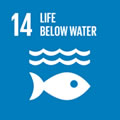Por favor, use este identificador para citar o enlazar a este item:
http://hdl.handle.net/10261/335507COMPARTIR / EXPORTAR:
 SHARE SHARE
 CORE
BASE CORE
BASE
|
|
| Visualizar otros formatos: MARC | Dublin Core | RDF | ORE | MODS | METS | DIDL | DATACITE | |

| Título: | Diversity of eukaryotic and prokaryotic microbiota revealed by metabarcoding in Neotropical floodplain lakes |
Autor: | Targueta, Cíntia P.; Antunes, Adriana Maria; Machado, Karine B.; Fernandes, Jordana G.; Galli Vieira, Ludgero C.; Logares, Ramiro CSIC ORCID ; Nabout, João C.; Soares, Thannya Nascimento | Palabras clave: | Araguaia river Aquatic community Environmental DNA Freshwater Genetic biodiversity |
Fecha de publicación: | 2023 | Editor: | Academia Brasileira de Ciências | Citación: | Anais da Academia Brasileira de Ciencias 95(Suppl1): e20201578 (2023) | Resumen: | The diversity of eukaryotic and prokaryotic communities has been assessed by morphological and genetic approaches, which are used to characterize the microbiota in different environments. Here, planktonic prokaryotic and eukaryotic communities of the Araguaia River, located in the Central region of Brazil, were analyzed based on metabarcoding analysis of rRNA genes to evaluate the diversity of these groups in tropical floodplain lakes. Also, we tested their spatial concordance throughout the Araguaia river. Water samples were collected from 8 floodplain lakes in Araguaia River. The 16S and 18S rRNA genes were amplified and sequenced using Illumina MiSeq. For eukaryotes, 34,242 merged reads were obtained and 225 distinct OTUs were delineated, of which 106 OTUs were taxonomically classified. For prokaryotes, 26,426 sequences were obtained and 351 OTUs were detected. Of them, 231 were classified in at least one taxonomic category. The most representative eukaryotes belonged to Ciliophora, Chlorophyta and Charophyta. The prokaryotic phylum with the most OTUs classified were Proteobacteria, Actinobacteria and Bacteroidetes. The lakes did not show spatial concordance when comparing the similarity between their microbiota. The knowledge of freshwater biodiversity using DNA sequencing for important rivers, such as Araguaia River, can improve microbiota inventories of tropical biodiversity hotspots | Descripción: | 12 pages, 5 figures, 1 table, supplementary material https://doi.org/10.1590/0001-3765202320201578 | Versión del editor: | https://doi.org/10.1590/0001-3765202320201578 | URI: | http://hdl.handle.net/10261/335507 | DOI: | 10.1590/0001-3765202320201578 | ISSN: | 0001-3765 | E-ISSN: | 1678-2690 |
| Aparece en las colecciones: | (ICM) Artículos |
Ficheros en este ítem:
| Fichero | Descripción | Tamaño | Formato | |
|---|---|---|---|---|
| Targueta_et_al_2023.pdf | 1,09 MB | Adobe PDF |  Visualizar/Abrir | |
| Targueta_et_al_2023_suppl.pdf | 925 kB | Adobe PDF |  Visualizar/Abrir |
CORE Recommender
Page view(s)
24
checked on 27-abr-2024
Download(s)
9
checked on 27-abr-2024
Google ScholarTM
Check
Altmetric
Altmetric
Este item está licenciado bajo una Licencia Creative Commons



